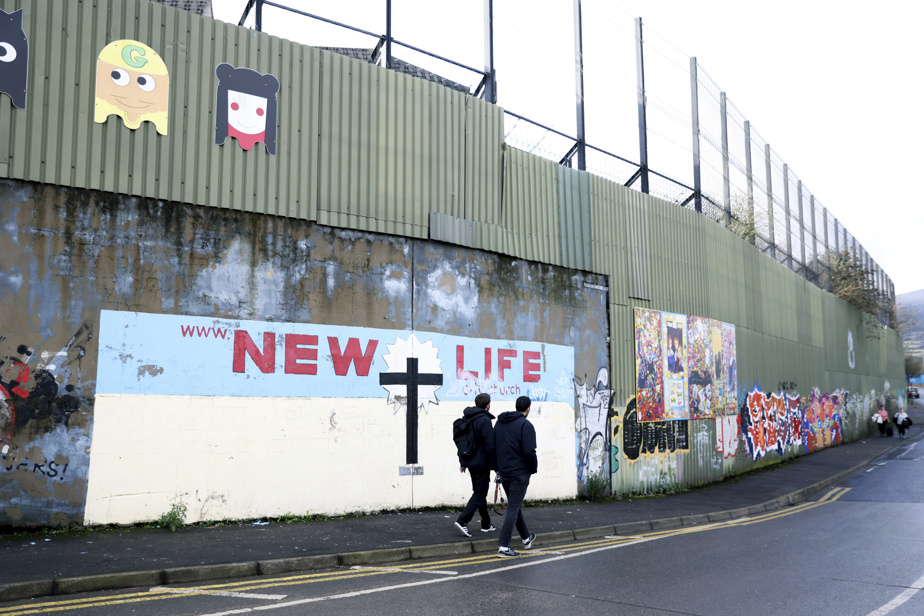What is it about ?

PHOTO DAVE CAULKIN, ASSOCIATED PRESS ARCHIVES
September 1994: Residents of Belfast West gather near the site of a car bomb explosion outside the headquarters of Sinn Féin, the main nationalist party.
Signed in Belfast on April 10, 1998, the Good Friday Agreement ended 30 years of civil war in Northern Ireland. This conflict between the Catholic community (nationalists, in favor of reunification with the Irish Republic) and Protestant (loyalists, for the maintenance of Northern Ireland in the United Kingdom) was marked by hundreds of bomb attacks and left 3,500 dead, including nearly 2,000 civilians. It will take four years of arduous discussions, overseen by London, Dublin and Washington, before peace is finally negotiated. “A huge relief,” recalls Duncan Morrow, 30 at the time, now professor of politics at the University of Ulster.
Why are we talking about it ?

PHOTO ARCHIVES ASSOCIATED PRESS
British soldiers watch the parade of the Ulster Defense Association, a loyalist Protestant paramilitary organization, in Belfast, August 1972.
Because we celebrate Monday the 25the anniversary of this historic agreement. Opportunity for Northern Ireland to reflect on how far it has come, through community activities, academic conferences and media events. Not insignificant: US President Joe Biden will travel to Belfast on Tuesday to highlight “the incredible progress since the signing of the agreement”, a signing which would not have been possible without the support of the United States.
What assessment?

INFOGRAPHIC THE PRESS
“Incredible progress”? Without a doubt. Because peace always holds, against all odds. “If you ask me if it was a success, the short answer is yes,” summarizes historian James Smyth, professor emeritus at Notre Dame University (Indiana). Despite everything, Ireland is still not healed from its wounds. The Catholic and Protestant communities still live in isolation, in neighborhoods sometimes separated by “walls of peace”, and the majority of schools are single-sex. Not to mention the paramilitary groups that continue to cause trouble on one side or the other, albeit marginally and without real support. “These are still separate worlds, even though there are efforts to integrate,” notes David Mitchell, a peace process expert at Trinity College Dublin.
Chronic instability

PHOTO PAUL FAITH, AGENCE FRANCE-PRESSE ARCHIVES
In Belfast, the “walls of peace” still represent a symbol of division between the Catholic and Protestant communities.
Moreover, the political situation is still far from perfect. Despite the creation of a Northern Irish Assembly in 1998 (Stormont), instability remains chronic. The Good Friday Agreement says the government is to be run jointly by a loyalist party and a nationalist party. Any decision must be taken in pairs and each camp has a right of veto allowing it to block decisions that do not benefit it, or to leave the government, which has the effect of regularly paralyzing Parliament. “Initially, the veto was designed to ensure that an acceptable level of mutual trust was maintained between the two parties,” explains Duncan Morrow. But its use has spread, to the point that it is now used in all sauces. It has become an issue in itself. The problem, adds James Smyth, “is that this structure is the core of the Good Friday agreement”…
A blocked Parliament
Between 2017 and 2020, Stormont ceased to operate after the main nationalist party, Sinn Féin, jumped ship over language policy. The Assembly has again been suspended for a year, with the resignation of the Democratic Unionist Party (DUP, loyalist) in protest against the “Northern Irish Protocol”. This Brexit provision was designed to avoid the return of a hard border between Northern Ireland and the Irish Republic (member country of the European Union), which could have awakened old ghosts. But it implies a moving border between England and Northern Ireland, which strongly displeases loyalists, who fear becoming second-class British citizens – hence the opposition of the DUP. A less restrictive version of the protocol (the “Windsor framework”) was signed at the end of February between London and the European Union. But the DUP continues to boycott the assembly. “Brexit has clearly complicated everything,” says Duncan Morrow.
What next?

PHOTO PETER MORRISON, ASSOCIATED PRESS ARCHIVES
In April 2021, the police intervened in a Belfast street to neutralize a clash between nationalists and loyalists.
Observers say the DUP is likely to return to government after municipal elections scheduled for May, with some minor concessions from London. Failure to do so would harm his cause, says David Mitchell. “Ultimately, they know they have to go back, because in the long term, this kind of blockage will give ammunition to those who plead for the reunification of the two Irelands, which they do not want. More and more voices are pleading for a more stable political system, which would necessarily involve changes to the Good Friday agreement. But any alternative to the current agreement would be likely to rekindle resentment within Northern Irish society, and to provoke further violence. In other words, it’s a dead end. “The power-sharing system is dysfunctional,” concludes James Smyth. Some compare it to institutionalized bigotry and they are not wrong. But for now, I don’t see any other solution. It’s still better than armed conflict…”
